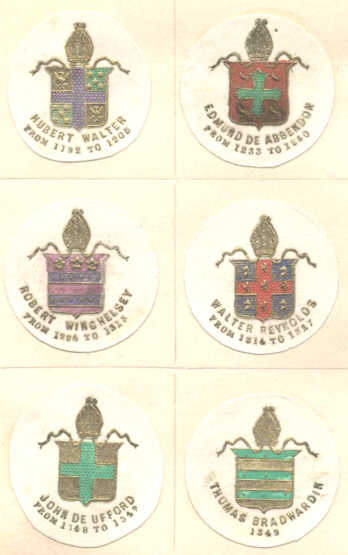
Page created 19 August 2001
EDWARD LAW
ARMS, CRESTS & MONOGRAMS
SETS
There were two principal sources of crests for the Victorian collector. The main one was from correspondence - collecting crests from envelopes and notepaper, and the surviving albums indicate just how prolific such material was.
When your correspondents did not run to crested stationery sets of crests could be purchased from a few firms who produced specifically for the collector, and there are not many albums which do not have at least one set among their pages.

Work still remains to be undertaken on the earliest publishers of sets, a practice which dates from 1862, the year in which crest collecting started to be promoted by commercial interests, specifically with the production of crest albums.
One of the best known of the early promoters was Thomas Culleton who was advertising material for albums in 1862 and who in 1863 was offering:
The crests used by the Army and Navy. The monograms and crowns of the Royal Family. Ditto, French Emperor and French Nobility. The arms of every Duke and Marquis. The crests and mottoes of the British commoners. The arms of every College in Oxford and Cambridge. The arms of all the Archbishops from 1070 to 1863. The above are all stamped in colours, price 1s per sheet, or 12 sheets for 9s. T Culleton, 25 Cranbourn St., WC.
Most publishers produced sets in these areas, and without an imprint positive identification is difficult. It seems very likely that the six crests here are from Culleton's set of Archbishops. For more material on Culleton and other publishers dealt with here see Heraldic.
 |
Other early promoters of the hobby of crest collecting also issued sets. Among them were Alfred Smith & Co. of Bath; Stafford, Smith & Co. of Brighton; and Stanley Gibbons & Co.
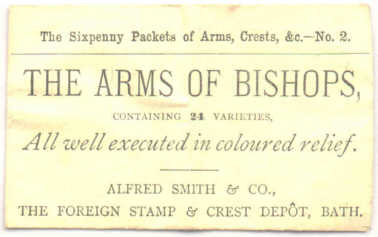 Alfred Smith & Co. advertised a half-crown
packet of 250 arms, crests and monograms, and also sold smaller
sixpenny packets, one of which is shown here.
Alfred Smith & Co. advertised a half-crown
packet of 250 arms, crests and monograms, and also sold smaller
sixpenny packets, one of which is shown here.
Stafford Smith & Co., (Stafford is thought to have been a brother to Alfred), offered five packets of 100 crests for 1s. 6d. each, which would form a collection of 500 different crests.
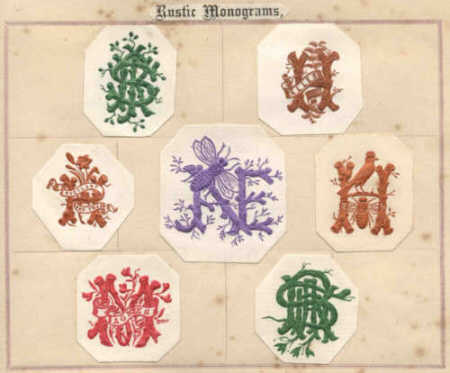 Their packet No. 4 comprised comic,
eccentric and rustic monograms, and it seems fairly clear that
the crests on the page displayed here, from a Stafford Smith
& Co's. Popular Series No. 1 album, with the label Rustic
Monograms are their product.
Their packet No. 4 comprised comic,
eccentric and rustic monograms, and it seems fairly clear that
the crests on the page displayed here, from a Stafford Smith
& Co's. Popular Series No. 1 album, with the label Rustic
Monograms are their product.
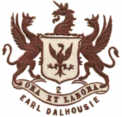 |
 |
The same album also contains sets of Lords/Earls: one among the 12 crests of each set carries a number (in these cases 2 and 3) below the arms, which is presumably a set number, an identifier for the publisher.
By the 1880s Stanley Gibbons & Co. were offering some 50 sets including most of the more popular subjects. Of particular interest was a set of 60 miniature crests which were "specially adapted for filling in the smaller spaces in Crest Albums."
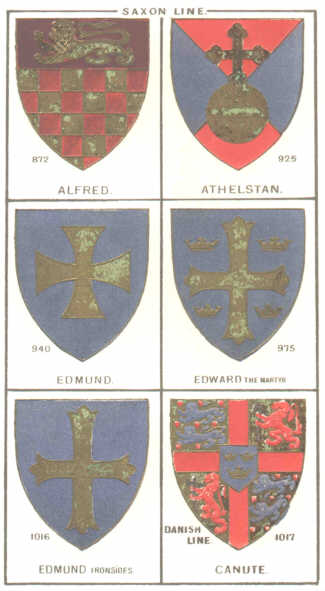
The frontispieces which some of the publishers included in their albums are also of assistance in identifying the output of the various firms, see Frontispieces for some examples of Stafford Smith & Co. and Stanley Gibbons & Co.
Advertisements and descriptions of the contents of sets of many of the publishers have been located, but because the same subjects were covered by different publishers they do not, on their own, identify material to specific publishers.
I have as yet no clues to the origin of the set shown here which is unusual in the topic and in the use of solid blocks of colour. The gilt burnishing has degraded in patches.
Having indicated that the topic of the early English royal line was unusual, the most popular sets were of royalty, but were those depicting the arms, monograms, crowns etc. of the then current royal family (Queen Victoria and her extended family), examples of which are found in many albums, and which often lead to misconceptions in the minds of the public.
Crest albums are
relatively common, I acquire them at the rate of about one a
month, but they are not  widely collected and because there has been
so little interest in them they are seldom displayed.
widely collected and because there has been
so little interest in them they are seldom displayed.
Because few people have seen albums they are often described as very rare, and the uninformed, encountering royal crests, make exaggerated claims of the royal connections of the collector. Above are three crests from a Lincoln 3rd edition album from Lincoln's Set 19, Royal Arms.
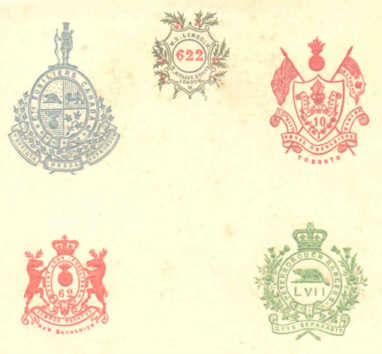 William S Lincoln was the most prolific of
set publishers, and the best documented, as his albums, which are
the most commonly encountered, nearly always carried a supplement
listing all his crest and philatelic products, including detailed
lists of sets by number and content. In his albums of the
beginning of the twentieth century he was offering over 250 sets
with most of the individual contents listed, which assists
identification. The sets were numbered up to the seven hundreds,
but there were large gaps in the numbering. Illustrated here is
the top half of Lincoln's set 622, one of seven sets of Canadian
Regiments serving in South Africa. The holly wreath around
Lincoln's name and address suggests that the set was issued for
the Christmas trade.
William S Lincoln was the most prolific of
set publishers, and the best documented, as his albums, which are
the most commonly encountered, nearly always carried a supplement
listing all his crest and philatelic products, including detailed
lists of sets by number and content. In his albums of the
beginning of the twentieth century he was offering over 250 sets
with most of the individual contents listed, which assists
identification. The sets were numbered up to the seven hundreds,
but there were large gaps in the numbering. Illustrated here is
the top half of Lincoln's set 622, one of seven sets of Canadian
Regiments serving in South Africa. The holly wreath around
Lincoln's name and address suggests that the set was issued for
the Christmas trade.
 |
Above is a section from a set of twelve armorial achievements of lords. This illustrates the uniformity of design: the motto ribbon, the scrolling under arms and supporters, and the name, which can assist in identifying sets. The appearance of a name is also often an indication that the crest is from a set: arms or crests on personal stationery would not have been identified with a name.
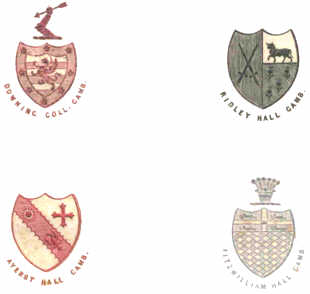
We have seen above, in Culleton's advertisement of 1863, that crests of the Universities were issued as sets from the earliest days of the hobby.
To the left is a section of a large (22.8cm x 17.5cm) sheet of 22 arms of the University and Colleges of Cambridges issued by J Boning, general stationer, 18 King's Parade, Cambridge. No doubt a period souvenir which probably sold widely to the visiting siblings of the undergraduates.

Another set of nine crests 'Illuminated crests of the Royal Navy, No 1' of which the foot is shown here, was probably produced for the same reason, and sold to visitors to naval ships at Portsmouth.
Gale & Polden, a
long established firm of army stationers based at Aldershot,
published the British Army Crest Album. They also published
packets of crests, each of which contained 48 regimental 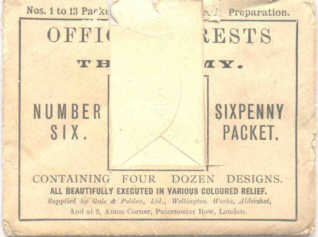 crests, at the price of sixpence each, post
free.
crests, at the price of sixpence each, post
free.
A contemporary review noted "They embrace over 700 varieties, each and all exceedingly well done. We suppose the Dies were primarily executed for the Stamping of Regimental Stationery." Their statement with regard to the origin of the dies was probably true and may account for the very low price at which they were able to sell the crests.
Illustrated here is their number six packet, with the crest from the front cut out. They also issued a small booklet which listed the contents of the individual packets, sixteen at that time. When they subsequently published a further five sets they issued small sheets of contents.
Return to HOME
or to TOPICS PAGE